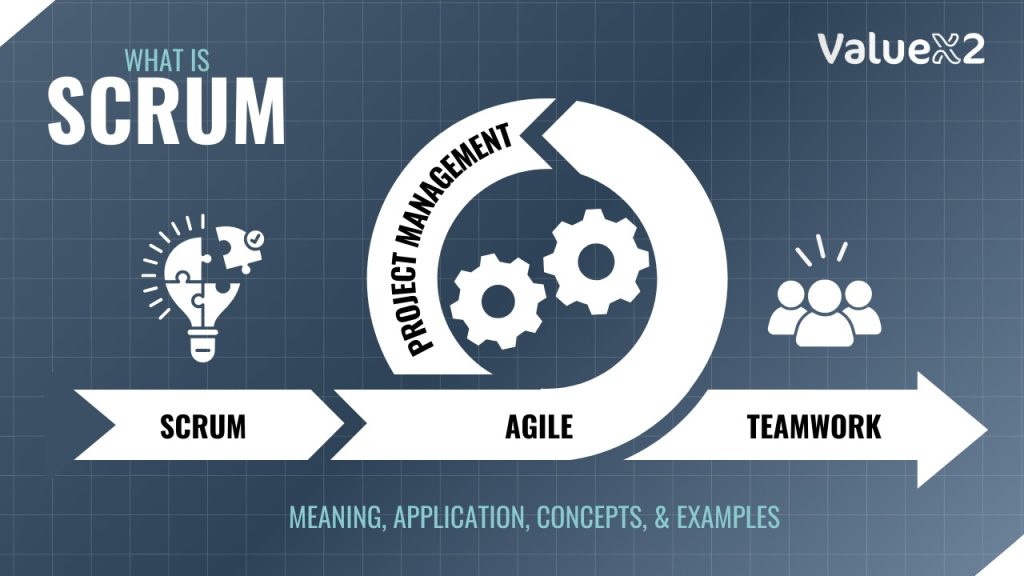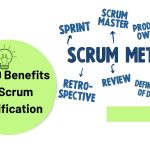Learn about Scrum methodology, principles, values, Scrum Artifacts, roles of Scrum Professionals, Scrum benefits, Scrum certifications, and more.

In simple terms, Scrum is a management framework that empowers teams to self-organize and work together. The whole team might be divided into smaller groups, but they are all working towards a common goal. So, to ensure a smooth project delivery, Scrum capitalizes on its set of practices, roles and tools. Picture this like a sports team training for a match, Scrum practices will make a team self-manageable, learn from experiences and easily adapt to changes.
Scrum Methodology
Scrum methodology is among many other Agile methodologies like Kanban and Lean. It is characterized using certain principles and values. This helps to govern and guide the framework effectively.
Principles of a successful Scrum project
1. Transparency
Teams operate in an environment where everyone is aware of the challenges faced by others. Regular face-to-face conversations among cross-functional team members and project owners prevent miscommunication and information blockages.
2. Manifestation
Built-in reflection points, like sprint reviews and retrospectives are there to allow teams to gain control of progress and make positive changes. With this, you can now have a better future layout and at the same time ensure projects run effectively and stay on track.
3. Irritability
Tasks can be reordered by teams in response to changing client demands. They make decisions on which tasks to prioritize and which to put off to keep the project in line with company goals.
Scrum Values for Project Teams
Scrum teams uphold and follow five co-values: boldness, commitment, openness, respect, and focus.
- Commitment: Members of the team are committed to meeting sprint goals and enhancing their workflows constantly.
- Bravery: To identify the greatest solutions, teams must be brave enough to pose difficult questions and have open and sincere conversations.
- Focus: Teams can produce excellent work within the Sprint deadline by concentrating on projects from the Product Backlog.
- Openness: Teams continue to be receptive to fresh perspectives and chances that improve individual growth and the calibre of the final product.
- Respect: Mutual cooperation and collaboration are fostered by a respectful culture, which is necessary for productive teamwork.
How does Scrum Work?
Scrum is organized around Sprints, which are set intervals of time that a team uses to concentrate on completing designated tasks. Every Sprint entails a set of actions and the application of multiple process-guiding artifacts.
What are Scrum Artifacts?
Scrum artifacts offer crucial data for organizing and managing tasks. The principal objects consist of:
- Product Backlog: A dynamic list of features, requirements, enhancements, and fixes that the team needs to complete. Maintained by the Product Owner, it is constantly updated to reflect changing priorities.
- Sprint Backlog: A subset of the Product Backlog items chosen for the current Sprint. It is flexible and can evolve as the Sprint progresses.
- Increment: The usable product resulting from a Sprint. It represents a step towards the final goal and must meet the team’s definition of “Done.”
The Roles of Scrum Professionals
1. Product Owner
He/she is basically in charge of ensuring that the team delivers maximum value to the business. They prioritize tasks, provide clear guidance, and act as a bridge between the business and the development team.
2. Scrum Master
Scrum Master or Leader, basically the same person. Encourages Scrum among team members, guaranteeing its efficacy. They lead meetings, remove obstacles, and provide Scrum practice coaching to the team and the company.
3. Development Team
The Development Team, which consists of developers, testers, designers, and other experts, collaborates to finish projects. They ensure that no individual becomes a bottleneck because they are cross-functional and self-organizing.
What are Scrum Ceremonies?
These are events or ceremonies, the same thing no difference, that are set up for a specified purpose. They occur often and are set up by and for Scrum Teams. Some of these events are:
Sprint Planning: Teams define the Sprint Goal and select items from the Product Backlog to work on during the Sprint.
Sprint: The time-boxed period during which the team works to achieve the Sprint Goal. Sprints typically last two weeks but can vary.
Daily Scrum or Stand-up: a brief daily meeting where team members talk about their advancement and any challenges. It facilitates prompt problem-solving and keeps everyone in agreement.
Sprint review: The team presents their work to stakeholders after the sprint. In response to comments, the product owner may potentially revise the product backlog.
Sprint retrospective: The team reflects on the Sprint, discussing what went well and what could be improved. This meeting aims to enhance future Sprints.
Scrum Benefits: Importance of Scrum in Software Development
Scrum has characteristics that make it valuable for software development, such as adaptability and focus on recurring improvement. Here is why Scrum is that crucial.
1. Sustaining Excellence
Frequent quality checks and feedback guarantee that the product lives up to expectations and stays current.
2. A higher ROI
Scrum helps reduce costs and enhance productivity by giving priority to jobs that give the most value and by taking a fail-fast strategy.
3. More Contented Teams
Teams that are self-managed and have the freedom to arrange their work create a positive and encouraging atmosphere that increases output and job satisfaction.
4. Better Approximation
Project schedules and budgets can be more precise and realistic when Scrum teams select their own KPIs.
Scrum Certification Courses
At ValuX2, we offer great agility courses that are recognized globally, with the best trainers to help you conquer the world of Agility.
Do you want to become a Scrum expert? To maximize the value of your products, you should take the Professional Scrum Product Owner (PSPO) course. To become a great Product Owner, you will learn what you need to know in this course on managing products, collaborating with stakeholders, and setting priorities.
Maybe you want a different experience, like mastering the Scrum framework, worry not as the Professional Scrum Master (PSM) course is perfect. It delves deeply into the specifics of Scrum, showing you how to facilitate smooth team dynamics, manage Scrum events, and support your team’s ongoing improvement. You will acquire the abilities to be a powerful and encouraging Scrum Master.
Now when you want to put your Scrum knowledge to practice then Applying Professional Scrum with PSM (APS) course is your gateway. Our trainers are equipped with the ability to teach and provide you with hands-on skills in real-world experiences and practical scenarios. From you can establish a connection between learning and doing. As a result, you will be able to lead Scrum teams and tackle complex projects with ease and confidence
Difference between Scrum and Agile
Agile is a more general concept that prioritizes value delivery and ongoing improvement. On the other side, Scrum is a particular Agile framework that offers an organized method for organizing and finishing work. Not all Agile practices are Scrum, even though all Scrum practices are Agile.
How Can Scrum Teams Adopt DevOps?
By uniting development and operations teams, improving teamwork, and automating procedures, DevOps enhances Scrum. Here’s how Scrum teams can use DevOps:
- For software deployment and testing automation.
- By using instruments for continuous delivery and integration.
- By allowing output to adjust after each sprint.
Conclusion
As we have looked at Scrum, we can come to a consensus that Scrum is a framework that effectively and efficiently works on complicated projects. Due to its ability to assist teams in producing high-quality products, its preference is really high compared to other frameworks. It promotes a culture of openness, flexibility, and continuous improvement. Scrum’s ideas and methods can significantly increase output and project success in the software development industry as well as other fields.

Bhavna is an Agile Coach and Consultant with over a decade of experience in advisory, corporate finance, IT assurance, and operations at Big 4 and within the industry in the UK and India. She has recently been the CEO of a start-up where she implemented agile practices within HR, Marketing, and Product teams.
She is also a SAFe® Practice Consultant (SPC) and authorized instructor for ICAgile Agility in HR (ICP-AHR), Agility in Marketing (ICP-MKG), and Business Agility Foundations (ICP – BAF) training courses. She provides training for agile transformation to corporate, public, and private batches, as well as consulting for enterprise agile transformation.






